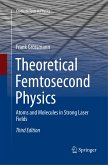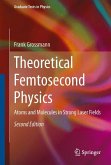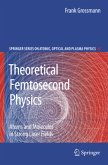This textbook extends from the basics of femtosecond physics all the way to some of the latest developments in the field. In this updated edition, the chapter on laser-driven atoms is augmented by the discussion of two-electron atoms interacting with strong and short laser pulses, as well as by a review of ATI rings and low energy structures in photo-electron spectra. In the chapter on laser-driven molecules a discussion of 2D infrared spectroscopy is incorporated.
Theoretical investigations of atoms and molecules interacting with pulsed lasers up to atomic field strengths on the order of 10^16 W/cm² are leading to an understanding of many challenging experimental discoveries. The presentation starts with a brief introduction to pulsed laser physics. The basis for the non-perturbative treatment of laser-matter interaction in the book is the time-dependent Schrödinger equation. Its analytical as well as numerical solution are laid out in some detail. The light field is treated classically and different possible gauges for the field-matter interaction are discussed. Physical phenomena, ranging from paradigmatic Rabi-oscillations in two-level systems to the ionization of atoms, the generation of high-order harmonics, the ionization and dissociation of molecules, as well as the control of chemical reactions are presented and discussed on a fundamental level. In this way, the theoretical background for state of the art experiments with strong and short laser pulses is given.
The new text is augmented by several additional exercises and now contains a total of forty-eight problems, whose worked-out solutions are given in the last chapter. In addition, some detailed calculations are performed in the appendices. Furthermore, each chapter ends with references to more specialized literature.
Theoretical investigations of atoms and molecules interacting with pulsed lasers up to atomic field strengths on the order of 10^16 W/cm² are leading to an understanding of many challenging experimental discoveries. The presentation starts with a brief introduction to pulsed laser physics. The basis for the non-perturbative treatment of laser-matter interaction in the book is the time-dependent Schrödinger equation. Its analytical as well as numerical solution are laid out in some detail. The light field is treated classically and different possible gauges for the field-matter interaction are discussed. Physical phenomena, ranging from paradigmatic Rabi-oscillations in two-level systems to the ionization of atoms, the generation of high-order harmonics, the ionization and dissociation of molecules, as well as the control of chemical reactions are presented and discussed on a fundamental level. In this way, the theoretical background for state of the art experiments with strong and short laser pulses is given.
The new text is augmented by several additional exercises and now contains a total of forty-eight problems, whose worked-out solutions are given in the last chapter. In addition, some detailed calculations are performed in the appendices. Furthermore, each chapter ends with references to more specialized literature.
From the reviews:
"It deals with the basics of femtosecond physics and goes ... with new phenomena and applications. ... the book presents an introduction to laser physics with mode-locking and pulsed laser operation. ... the solution of the time-dependent Schrödinger equation is discussed both analytically and numerically. ... In conclusion, it is a strong book in which the table of contents for this modern research field has been selected very carefully and the topics are treated adequately." (Wim Joosen, Belgian Physical Society Magazine, Issue 2, June, 2009)
"Theoretical Femtosecond Physics: Atoms and Molecules in Strong Laser Fields fills an important need for a thorough introduction of the theory behind the high-field laser physics phenomena on which this emerging research field is based. ... I highly recommend Grossmann's book to anyone interested in entering this rapidly developing field." (Franz X. Kärtner, Physics Today, November, 2009)
"It deals with the basics of femtosecond physics and goes ... with new phenomena and applications. ... the book presents an introduction to laser physics with mode-locking and pulsed laser operation. ... the solution of the time-dependent Schrödinger equation is discussed both analytically and numerically. ... In conclusion, it is a strong book in which the table of contents for this modern research field has been selected very carefully and the topics are treated adequately." (Wim Joosen, Belgian Physical Society Magazine, Issue 2, June, 2009)
"Theoretical Femtosecond Physics: Atoms and Molecules in Strong Laser Fields fills an important need for a thorough introduction of the theory behind the high-field laser physics phenomena on which this emerging research field is based. ... I highly recommend Grossmann's book to anyone interested in entering this rapidly developing field." (Franz X. Kärtner, Physics Today, November, 2009)
Aus den Rezensionen: "... Die ... Monografie ... richtet sich ... an Studierende in höheren Semestern, ... auch erfahrene Wissenschaftler werden aus diesem Buch großen Nutzen ziehen. ... Sehr gut gefallen haben mir ... die Darstellung der Erzeugung von höheren Harmonischen von Licht und die kohärente Kontrolle von molekularer Dynamik. In diesem Bereich gelingt es dem Autor in hervorragender Weise, in den momentanen Stand der Wissenschaft einzuführen. Detaillierte Anhänge erlauben ein tieferes Verständnis. Sehr hilfreich sind ... die ... Literaturangaben ... Das Buch ist von einem Experten verfasst ... Ich kann es ... wärmstens empfehlen." (Wolfgang P. Schleich, in: Physik Journal, 06/2009, Vol. 8, Issue 6, S. 53)








